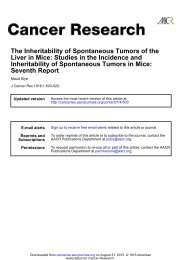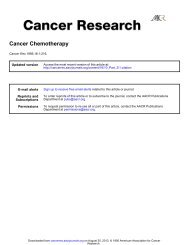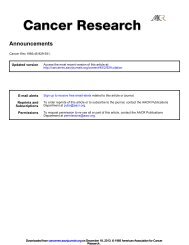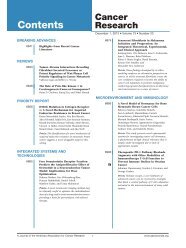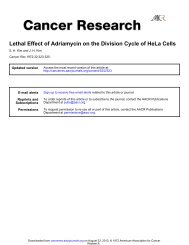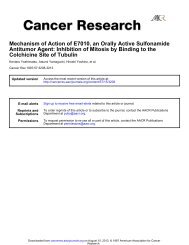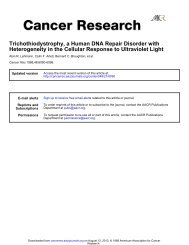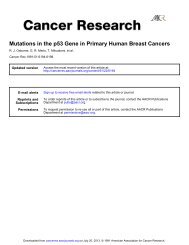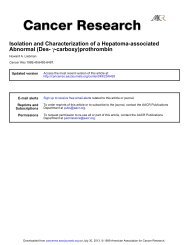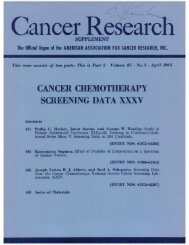XANTHOMA OF THE BREAST In a series of nine hundred (circa ...
XANTHOMA OF THE BREAST In a series of nine hundred (circa ...
XANTHOMA OF THE BREAST In a series of nine hundred (circa ...
You also want an ePaper? Increase the reach of your titles
YUMPU automatically turns print PDFs into web optimized ePapers that Google loves.
Downloaded from cancerres.aacrjournals.org on December 28, 2013. © 1932<br />
American Association for Cancer Research.<br />
1094 CUSHMAN D. HAAGENSEN<br />
Present Illness: Thirty-seven years previously, while she was nursing<br />
her first baby, the patient had noticed a lump within the right nipple.<br />
About one year before admission she noticed that the whole right breast<br />
was enlarged. For one month there had been intermittent bleeding from<br />
the right nipple.<br />
Physical Examination: The whole right breast was occupied by a huge<br />
multilocular, cystic tumor which was not adherent to the overlying skin.<br />
The tumor was movable over the chest wall. There were no palpable<br />
axillary or supraclavicular nodes. The urine showed 0.8 per cent sugar<br />
and a trace <strong>of</strong> albumin but no casts. The blood sugar was 145.6 mg.<br />
The blood pressure was 150 systolic and 74 diastolic.<br />
A presumptive diagnosis <strong>of</strong> papillary cystadenocarcinoma was made.<br />
Treatment: The patient was put on a diabetic regime until her diabetes<br />
was in a satisfactory condition and on May 11, 1928, a local mastectomy<br />
was done. Healing was without incident and the patient continues free<br />
<strong>of</strong> disease three and one half years later.<br />
Gross Diagnosis (Pathologic Specimen No. B 4717): The specimen<br />
consists <strong>of</strong> a breast bearing; an ulceration 6.5 em. in diameter. The floor<br />
<strong>of</strong> the ulcer is composed <strong>of</strong>s<strong>of</strong>t lobulated tumor nodules covered with a<br />
grayish exudate. On section the breast is seen to be replaced by a tumor<br />
mass measuring 15 x 11 x 10 em. It is enclosed in a thick, fibrous capsule.<br />
The tumor is distinctly lobulated throughout, and in its viable<br />
portions is composed <strong>of</strong> firm, gray gelatinous tissue. There are caseous<br />
and also calcified areas, as well as degenerated areas containing thick<br />
greenish fluid.<br />
Microscopic Diaqnosis: The tumor (Figs. 11 and 12) is a giant intracanalicular<br />
fibro-adenoma. It is largely myxomatous. Superficially it<br />
is infected. <strong>In</strong> several regions there is well marked xanthomatous degeneration.<br />
Here typical foam cells with small round nuclei and a prominent,<br />
lightly staining reticular cytoplasm replace the fibrous structure.<br />
Numerous crystals surrounded by giant cells are seen.<br />
Diaqnoeis: <strong>In</strong>tracanalicular fibro-adenoma showing myxomatous and<br />
xanthomatous degeneration.<br />
COMMENT: <strong>In</strong> this case the diabetes with its accompanying<br />
disturbance in the cholesterin metabolism may have been an<br />
etiological factor in the development <strong>of</strong> secondary xanthomatous<br />
degeneration in the breast tumor.<br />
(2) Secondary Xanthomatous Degeneration in <strong>In</strong>flammatory<br />
Processes in the Breast: Chronic breast abscesses are particularly<br />
apt to show secondary xanthomatous degeneration. It has been<br />
frequently observed in various types <strong>of</strong> low-grade inflammation in<br />
the breast. Lobeck reported a case <strong>of</strong> acute mastitis and one <strong>of</strong><br />
chronic cystic mastitis which contained areas <strong>of</strong> xanthomatous<br />
degeneration and showed an accompanying hypercholesterinemia.<br />
The following case, illustrative <strong>of</strong> secondary xanthomatous



